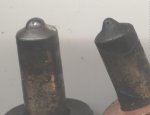Bjorn,
Some of your questions are addressed in my forthcoming book (hence the copyright notation below),but I will be happy to answer some of them here. And I'll warn all, some of these answers will probably not coincide with preconceived notations, which when I was teaching classes on such subjects always seemed to be the biggest stumbling block. I'll starting with Question #1: How does a blocked injector cause the hydraulic head to fail?
First, we have to understand the basics. All the pump does is to power the volume of liquid, the nozzle office is what generates pressure, and controls the spray pattern - the pump itself is not what generates pressure. An everyday comparison is your garden hose, turn on the spigot, and water flows freely, with very little pressure, place your finger in front of the hose end, and begin closing the gap, and the pressure increases. Your finger is creating an office with respect to the end of the hose. The smaller the office (closer your finger is), the greater the pressure. This is the basic principle of any nozzle, injector or otherwise.
The Bosch IP on the Multifuel has two pumps, the hydraulic head, and the supply pump - which each work completely differently. The supply pump is what is known as a gear pump, two gears run together, and push the fluid (fuel) forward through them - rather like the wringer on an old fashioned washing machine or your wife's pasta machine. How the supply pump works is immaterial to your problem, but is included here for reference.
The hydraulic head is the "high pressure" pump - in fact, the hydraulic head is the true "pump" in the injection pump. In technical terms, it is a positive displacement plunger pump. In fact, the plunger is what is under the hex-shaped plug in the top of the hydraulic head. The bottom end of the IP times the stroke of the plunger properly with respect to the position of the pistons in the engine, and also times the rotation of the plunger sleeve, so that fuel flow is directed to the correct fuel line - rather like the rotor in an older gas engine ignition system. But, for the moment, forget that it we are dealing with an injection pump, or that there are multiple cylinders.
In a positive displacement pump, with each cycle of the pump, a specific amount of fluid POSITIVELY will be moved. In the case of the hydraulic head, with each stroke of the plunger, a fixed amount of fluid (fuel) WILL be moved. The bottom end of the IP varies the stroke, and the fuel flow, and shut off. The fuel is an incompressible fluid. A positive displacement pump that we are all somewhat familiar with is a syringe (although syringes are "cup pumps", it is still a positive displacement pump, so the comparison works). When you depress the plunger of a syringe, the fluid will move. Now, if you plug the outlet, and apply enough force to the plunger of the syringe, something will break, and the fluid will move.
That is exactly what happened to your hydraulic head (and precisely why there are so many fuel filters on these trucks) - the nozzle clogged, and on the next upward stroke of the plunger there was no place for the fluid to go, so something had to break - it could have been something in the bottom end of the pump (and frankly, I'm surprised nothing down there was damaged - and maybe it was), it could have blown the end off of the injector - which would have destroyed the cylinder, it could have split a fuel line, or it could have cracked the hydraulic head. In any event, the fluid HAD to move.
As far as testing the failed head - it truly is a paperweight or a pound or so of scrap metal - but you may want to dismantle it to see how it is made. Starting with a solid cylinder of steel, holes are bored parallel to its axis, this are the bore for the plunger, and the connecting points for the injection lines. Other holes are bored perpendicular to the axis, connecting the central bore to six radial bores. The outer ends of these perpendicular bores are then sealed with Allen-headed plugs. (The only other way to make the head would be through EDM machining, which would be VERY costly). I have simplified this slightly, but this covers the basics. When your nozzle clogged, the fluid found its way out around one of these plugs, likely eroding the threads on the way.
Testing injectors requires specialized equipment, and can be dangerous for the untrained - the nozzle generates considerable force, and is capable of blasting fuel THROUGH your skin, and into the bloodstream, with potentially fatal results. Best bet, read the TM and buy the proper equipment, or let your local diesel shop do this.
I'm out of time for now, but will try to address some of your other questions later today. However, an unusual knock from a compression-ignition engine is often related to a timing issue. Since your engine was nicely running along when suddenly the IP pump tried to stop (when the nozzle clogged), and because the timing gears are slotted, it is possible that the timing changed oh so slightly. Also, if the other nozzles are clogging, this will alter their spray pattern. The Multifuel depends on the precise placement of the bulk of the fuel in the combustion chamber in the top of each piston for its smooth combustion - if the placement is not correct - or if excess carbon deposits alter the air flow inside the combustion chamber, atomization of the fuel won't occur properly. This could cause ignition delay (in effect, changing the timing in the cylinder itself) with a resultant knock.
Note the comments in the last paragraph pertain ONLY to the Multifuel - a conventional diesel relies on the injector nozzles to atomize the fuel - a Multifuel is very different.
Hope this helps,
David Doyle
Copyright 2006




